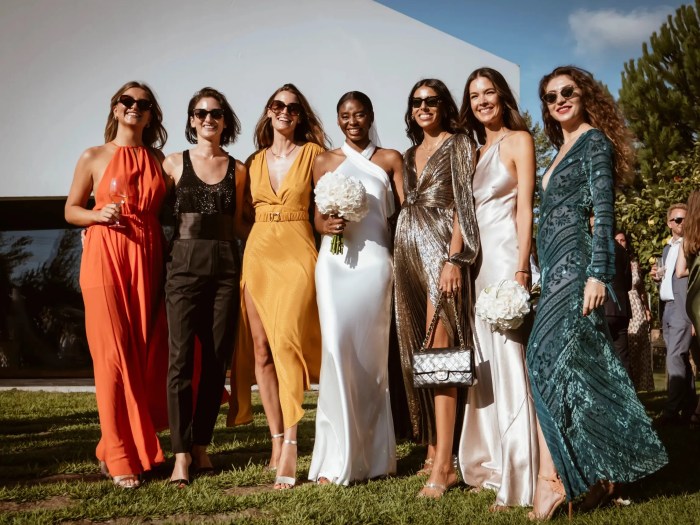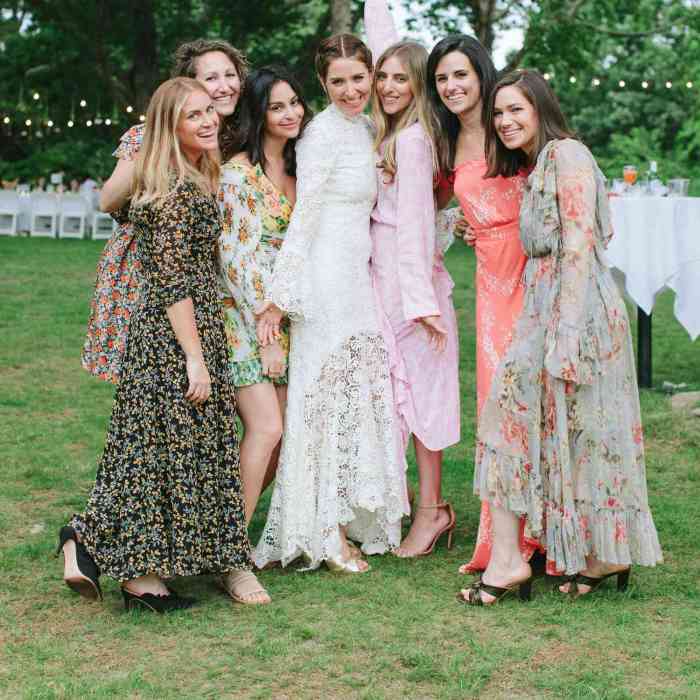Wedding Reception Dress Styles

Source: vogue.com
Dresses for a wedding reception – Choosing the perfect dress for a wedding reception can be exciting but also overwhelming. This guide explores various dress styles, dress codes, fabric and color choices, accessories, and the process of finding your ideal outfit. Remember to always consider the wedding’s formality and the venue when making your selection.
Choosing the right attire for a wedding reception can be a fun yet challenging task. The options are vast, ranging from elegant gowns to stylish jumpsuits. If you’re attending an Indian wedding reception, however, consider exploring the vibrant and diverse options available, as detailed in this helpful guide: dress for indian wedding. Returning to general reception attire, remember to select an outfit that reflects the formality of the event and your personal style.
Types of Wedding Reception Dresses, Dresses for a wedding reception
Numerous dress styles are appropriate for wedding receptions, depending on the formality and venue. The following table provides a detailed overview.
| Dress Style | Description | Suitable Occasions | Example Fabrics |
|---|---|---|---|
| Cocktail Dress | Generally knee-length or slightly shorter, often featuring embellishments or unique details. Can range from semi-formal to formal depending on design. | Semi-formal to formal receptions, cocktail parties. | Lace, silk, velvet, crepe |
| Midi Dress | Falls between knee-length and ankle-length, offering versatility for various occasions. | Semi-formal to informal receptions, garden parties. | Cotton, linen, silk, jersey |
| Maxi Dress | Floor-length dress, often more formal and elegant. | Formal receptions, black-tie optional events. | Silk, chiffon, crepe, velvet |
| Jumpsuit | Stylish alternative to a dress, offering comfort and sophistication. | Semi-formal to formal receptions, depending on fabric and style. | Silk, crepe, satin, linen |
| Separates | A skirt and top combination, allowing for personalized style. | Informal to semi-formal receptions. | Cotton, silk, lace, linen |
Outfit Examples for Different Venues
Three distinct outfits demonstrate how dress style can adapt to various reception venues.
- Formal Reception (Ballroom): A flowing maxi dress in navy blue silk, paired with delicate silver jewelry, a small clutch, and elegant heels. The dress features a subtle v-neckline and a fitted bodice that flows into a full skirt.
- Informal Reception (Garden): A floral midi dress in a lightweight cotton fabric, accessorized with straw hat, wedges, and a crossbody bag. The dress’s playful print complements the relaxed atmosphere.
- Beach Reception: A flowing jumpsuit in a light-colored linen fabric, paired with simple gold jewelry, flat sandals, and a wide-brimmed sunhat. The linen fabric is breathable and comfortable for a beach setting.
Factors Influencing Dress Choice
Several factors influence the appropriateness of a wedding reception dress.
- Formality of the Wedding: A formal wedding requires a more elegant dress than a casual one.
- Venue: The venue dictates the level of formality and the suitability of different dress styles.
- Season: Fabric choices should be appropriate for the season; lightweight fabrics for summer and heavier fabrics for winter.
- Dress Code: The dress code explicitly indicates the level of formality expected.
Dress Code Considerations
Understanding different dress codes is crucial for choosing appropriate attire.
- Black-Tie Optional: A floor-length gown or a sophisticated cocktail dress is suitable. Think elegant fabrics and embellishments.
- Cocktail Attire: A cocktail dress, midi dress, or a stylish jumpsuit are appropriate choices. The dress should be elegant but not overly formal.
- Casual: A stylish midi dress, a chic jumpsuit, or separates are suitable. Comfort and style are key.
Wedding Guest Attire Etiquette
Avoiding common etiquette mistakes ensures respectful attire.
- Avoid wearing white or ivory, as these are traditionally reserved for the bride.
- Refrain from wearing overly revealing or attention-grabbing outfits.
- Choose attire that is appropriate for the venue and the time of day.
- Ensure your outfit is clean, well-fitting, and in good condition.
Bride’s Dress Style Impact

Source: brides.com
The bride’s dress style indirectly influences guest attire. Guests should choose dresses that are complementary and respectful, avoiding styles that might overshadow the bride’s attire.
Fabric and Color Choices
Fabric and color choices are essential for creating a seasonally appropriate and stylish look.
- Summer Fabrics: Cotton, linen, silk, chiffon, chambray
- Winter Fabrics: Velvet, brocade, wool, lace, heavier silks
Color Choice Considerations
Color choices should complement the wedding’s theme and the season. Bright colors are generally suitable for summer weddings, while deeper, richer colors are more appropriate for winter.
- Pros of Pastel Colors: Elegant, soft, and appropriate for spring and summer weddings.
- Cons of Bright Colors: Can be too vibrant for formal weddings.
- Pros of Jewel Tones: Luxurious, sophisticated, and suitable for autumn and winter weddings.
- Cons of Dark Colors: Might be too somber for daytime weddings.
Color Palettes
Three color palettes demonstrate options for different seasons and venues.
- Summer Garden Wedding: Pastel pink, mint green, lavender. Accessories: straw hat, light-colored sandals, delicate jewelry.
- Autumn Vineyard Wedding: Burgundy, deep teal, gold. Accessories: statement earrings, ankle boots, a clutch.
- Winter Ballroom Wedding: Navy blue, emerald green, silver. Accessories: sparkly heels, a shawl, a jeweled clutch.
Accessories and Styling
Accessories can elevate a wedding reception outfit.
| Accessory Type | Examples | Matching Dress Styles | Styling Tips |
|---|---|---|---|
| Jewelry | Necklaces, earrings, bracelets, rings | All dress styles | Choose pieces that complement the dress and your personal style. Avoid being too flashy. |
| Handbags | Clutches, crossbody bags, small totes | All dress styles | Choose a bag that is appropriate for the size and formality of the event. |
| Shoes | Heels, wedges, flats, sandals | All dress styles | Select shoes that are comfortable and complement the outfit. |
| Wraps/Shawls | Pashminas, boleros, stoles | All dress styles | Provide warmth and add a touch of elegance. |
Styling Concepts
Three styling concepts demonstrate accessory choices for different dress styles.
- Midi Dress: A floral midi dress paired with nude heels, a delicate necklace, and a small crossbody bag. The overall look is feminine and chic.
- Maxi Dress: A flowing maxi dress paired with statement earrings, a clutch, and elegant heels. The look is sophisticated and glamorous.
- Jumpsuit: A wide-leg jumpsuit paired with a statement belt, simple jewelry, and heeled sandals. The look is both stylish and comfortable.
Choosing the Right Accessories
Selecting accessories that complement personal style and the overall dress code creates a cohesive and stylish look. Consider the formality of the event and the overall aesthetic of your dress when choosing accessories.
Finding the Perfect Dress
Finding the perfect dress involves several steps.
- Set a Budget: Determine how much you’re willing to spend.
- Shop Online and In Stores: Explore various options and try on dresses to find the best fit.
- Consider Alterations: Tailoring can enhance the fit and style of your dress.
Importance of Trying on Dresses
Trying on dresses before purchasing is crucial to ensure proper fit and style. Consider factors such as comfort, silhouette, and overall look.
Tips for Dress Selection
Choosing a dress that flatters your body type and personal style enhances confidence and comfort.
- Consider your body shape and choose a dress that accentuates your best features.
- Select a dress that reflects your personal style and makes you feel confident.
- Ensure the dress is comfortable and allows for easy movement.
- Choose a dress that is appropriate for the venue and the occasion.
FAQs: Dresses For A Wedding Reception
What if the invitation doesn’t specify a dress code?
If unsure, err on the side of slightly more formal attire. A midi dress or a stylish jumpsuit are generally safe choices.
How far in advance should I start shopping for a wedding reception dress?
Ideally, begin shopping at least 6-8 weeks prior to the event to allow time for alterations and shipping if ordering online.
Can I wear white to a wedding reception?
Generally, it’s best to avoid wearing white to a wedding as it is traditionally reserved for the bride. Off-white or ivory shades are usually acceptable.
What are some budget-friendly options for finding a wedding reception dress?
Consider shopping at department stores, online retailers, or consignment shops for more affordable options. Renting a dress is also a viable choice.
